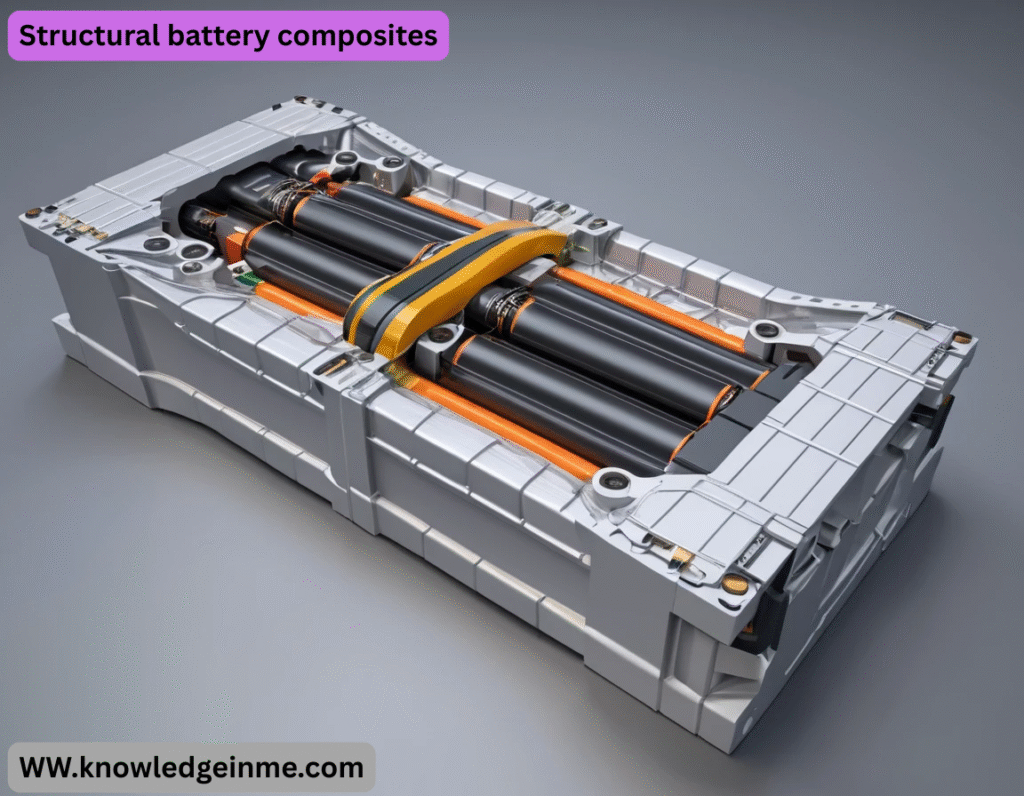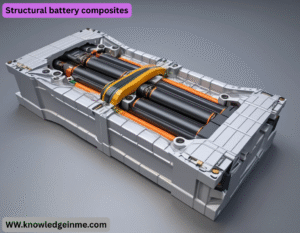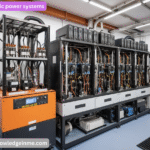Structural battery composites (SBCs) represent a cutting-edge innovation in materials science, combining load-bearing capability with energy storage in a single multifunctional material. By integrating the functions of a battery and a structural component, SBCs aim to reduce weight, improve efficiency, and enable new design possibilities in applications like electric vehicles (EVs), aerospace, and portable electronics.
Concept & Working Principle
- Traditional batteries (e.g., Li-ion) are add-on components that occupy space and add weight without contributing to structural integrity. In contrast, SBCs merge the electrode and electrolyte materials into a composite structure, allowing them to:
- Store energy (like a battery).
- Withstand mechanical loads (like a structural material).
Key Components:
- Structural Electrodes: Carbon fibers (anode) and lithium-coated fibers (cathode) serve dual roles (conductivity + strength).
- Solid Polymer Electrolyte: Replaces liquid electrolyte, providing ionic conductivity while maintaining mechanical stability.
- Reinforcement Matrix: Often epoxy or other polymers that bind fibers while allowing ion transport.
Advantages of Structural Batteries
- Weight Reduction: Eliminates separate battery packs, crucial for EVs and aircraft.
- Space Efficiency: More compact designs possible.
- Improved Energy Density: Multifunctionality enhances system-level efficiency.
- Enhanced Safety: Solid electrolytes reduce leakage/thermal risks.
Challenges & Limitations
- Trade-off Between Strength & Energy Storage: Optimizing one property may compromise the other.
- Cycle Life & Durability: Repeated mechanical stress may degrade performance.
- Cost: Advanced materials (e.g., carbon fiber, solid electrolytes) are expensive.
Current Research & Developments
- Solid-State Electrolytes: Safer and more mechanically robust than liquid electrolytes.
- 3D-Printed SBCs: Additive manufacturing enables customized designs.
- Self-Healing Composites: To extend lifespan under mechanical stress.
Potential Applications
- Electric Vehicles: Lighter cars with longer range.
- Aerospace: Reduced weight in drones, satellites, and aircraft.
- Wearable Electronics: Flexible, load-bearing energy storage.
- Civil Engineering: Smart infrastructure with energy-storing components.
Core Materials & Design Approaches
Electrode Materials
- SBCs require electrodes that are both structurally robust and electrochemically active.
Anode Materials
- Carbon Fiber (CF) Anodes:
- High stiffness (~200–500 GPA) and conductivity.
- Can intercalate lithium ions (Li⁺) for energy storage.
Silicon-Carbon Hybrids:
- Research focuses on nanostructured Si to mitigate cracking.
Cathode Materials
- Lithium Iron Phosphate (LFP)-Coated Fibers:
- Good stability but lower energy density.
- Lithium Nickel Manganese Cobalt Oxide (NMC) Composites:
- Higher energy density but more sensitive to mechanical stress.
Structural Conductive Polymers:
- Polymeric cathodes (e.g., polyaniline) with embedded active materials.
Electrolyte Systems
- Since liquid electrolytes compromise mechanical properties, solid-state electrolytes (SSEs) are preferred:
- Polymer Electrolytes (e.g., PEO-LiTFSI):
- Ceramic Electrolytes (e.g., LLZO, Li₇La₃Zr₂O₁₂):
- High modulus (~150 GPA) but brittle.
Hybrid Solid Electrolytes:
- Combining polymers with ceramics (e.g., PEO + LLZO nanoparticles) for balanced properties.
Matrix Materials
The matrix binds fibers while allowing ion transport
- Structural Polymers (Epoxy, PMMA):
- High strength but poor ionic conductivity.
Ion-Conducting Polymers:
- Modified epoxies with Li⁺ pathways (e.g., epoxy-LIClO₄).
State of the Art Research 2020 2024
- Chalmers University (Sweden) – Carbon Fiber SBCs
Performance:
- Energy density: 24 WH/kg (structural) vs. ~250 WH/kg (Li-ion).
- Stiffness: ~25 GPA (vs. ~70 GPA for CF/epoxy).
- Limitation: Low energy density due to thick electrolyte layers.
University of Michigan – Solid-State SBCs
- Design: Glass-fiber-reinforced SSE with Li-metal anode.
Performance:
- Flexural strength: ~300 MPA.
- Capacity retention: 80% after 100 cycles.
NASA – SBCs for Aerospace
- Goal: Replace satellite structural panels with energy-storing composites.
- Approach: 3D-printed graphene-lithium cells embedded in epoxy.
Key Challenges & Future Directions
Major Challenges
- Low Energy Density: Current SBCs store <25% energy of Li-ion.
- Cycle Life Degradation: Mechanical stress accelerates capacity fade.
- Manufacturing Scalability: Hand layup vs. automated fiber placement (AFP).
- Cost: High-performance carbon fiber + solid electrolytes are expensive.
Emerging Solutions
- Self-Healing Electrolytes: Polymers that repair cracks.
- Multiscale Modeling: AI-driven optimization of microstructures.
- Hybrid Energy Systems: Combining SBCs with supercapacitors for burst power.
Advanced Fabrication Techniques for SBCs
Fiber-Based Manufacturing
- Continuous Fiber Electrodes
- Process: Carbon fibers are coated with active materials (e.g., Si for anodes, LFP for cathodes) via:
- Electrophoretic Deposition (EPD)
- Chemical Vapor Deposition (CVD)
- Example: Chalmers University’s roll-to-roll coated CF anodes.
Multifunctional Weaving
- Approach: Interlacing conductive fibers (anode/cathode) with insulating separators.
- Challenge: Preventing short circuits while ensuring ion transport.
Solid Electrolyte Integration
- In-Situ Polymerization
- Liquid monomer infused into fiber layers, then cured (e.g., UV-polymerized PEGDA).
- Advantage: Ensures intimate electrode-electrolyte contact.
- Ceramic-Polymer Hybrid Electrolytes
- Example: LLZO (Li₇La₃Zr₂O₁₂) nanoparticles dispersed in PEO matrix.
- Benefit: Combines high ionic conductivity (10⁻⁴ S/cm) with mechanical robustness.
Additive Manufacturing (3D Printing)
- Direct Ink Writing (DIW)
- Materials: Shear-thinning inks with carbon fibers + Li-active materials.
- Application: Customized battery shapes (e.g., drone wings).
Selective Laser Sintering (SLS)
- Process: Laser-fuses polymer/ceramic powders into solid electrolytes.
- Example: NASA’s 3D-printed graphene-LiMn₂O₄ cells.
Industry Prototypes & Case Studies
Electric Vehicles (EVs)
- Volvo’s SBC Car Project (2021–Present)
Performance:
- 50% weight reduction vs. steel + battery pack.
- Energy contribution: ~1 kWh (supplementary to main battery).
- Tesla’s Structural Battery Patents (2023)
- Concept: Aluminum honeycomb cells with Li-ion electrodes.
- Goal: Replace floor panels in Cyber truck.
Aerospace & Defense
- Airbus’ “Wing of Tomorrow” (2025 Target)
- SBC Role: Energy-storing wing spars for hybrid-electric aircraft.
- Challenge: Achieving FAA-certifiable mechanical stability.
Lockheed Martin’s Satellite Panels
- Approach: Si-anode SBCs replacing aluminum chassis in CubeSats.
- Benefit: 30% mass savings → lower launch costs.
Consumer Electronics
- Samsung’s Foldable Phone Battery (Patent)
- Design: Carbon-nanotube-reinforced Li-polymer cells.
- Advantage: Bendable yet rigid enough for hinge support.
Roadmap: From Lab to Market
Short-Term (2024–2028)
- Focus: Improve cycle life (>500 cycles) and energy density (>50 WH/kg).
Applications:
- High-end drones (e.g., military UAVs).
- Luxury EV components (e.g., door panels).
- Medium-Term (2028–2035)
Goals:
- Energy density >100 WH/kg (competitive with conventional Li-ion).
- Automated mass production (e.g., AFP for automotive).
Applications:
Mainstream EV structural packs (replacing 20–30% of body-in-white).
- EVTOL aircraft primary structures.
- Long-Term (Post-2035)
Vision:
- “Battery-less” EVs: Entire chassis as energy storage.
- Self-powered infrastructure: Bridges with SBCs storing solar energy.
Breakthroughs Needed:
- AI-optimized materials: Machine learning for composite design.
- Room-temperature solid-state SBCs: Eliminating thermal management.
Open Questions & Debates
- “Is energy density or mechanical performance the limiting factor?”
- Argument: For EVs, energy density is critical; for aerospace, strength matters more.
“Can SBCs ever fully replace Li-ion packs?”
- Counterpoint: Likely hybrid systems (SBCs + conventional batteries) will dominate.
Failure Mechanisms & Durability Challenges
Critical Failure Modes
- Electrochemical-Mechanical Decoupling
- Problem: Repeated charge/discharge causes swelling/contraction → fiber-matrix debonding
- Example: Silicon anodes expand ~300% → composite delamination in <50 cycles
- Dendrite Penetration in Solid Electrolytes
Current Solutions:
- Nanostructured ceramic electrolytes (LLZO with Al doping)
- Polymer-ceramic “sandwich” layers (UMICH 2023 design)
Interfacial Degradation
- Data: 40% impedance increase after 100 cycles (Chalmers 2022 study)
- Innovation: Atomic layer deposition (ALD) of Al₂O₃ on fibers
TCO Comparison (EV Battery Pack)
- Conventional: $140/kWh + $12/kg structural weight
- SBC (2030): $210/kWh (but eliminates $8/kg structural cost)
- Break-even Point: 400km+ range vehicles (Volvo 2025 analysis)






